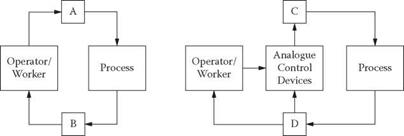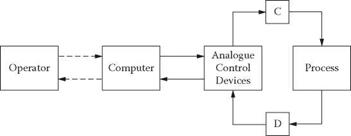Toni Ivergard and Brian Hunt
CONTENTS
1.1 ![]() Computerisation……………………………………………………………..
Computerisation……………………………………………………………..
1.2 Paradigm Shift: From Control Rooms to Control Centres
References and Further Reading……………………………………………….
Traditionally, human work was of the handicraft type engaged in by workers using only the very simplest of tools. Normally, whole handicraft items were produced by the work of one person from beginning to end. This traditional approach to the organisation of the work process began to change during the industrial revolution. Industrialisation brought large and complex machines into the workplace, though these were initially only used to augment the available power—workers were still operating manufacturing machinery by hand. Perhaps the largest change occurred in the organisation of work. Instead of a single worker making the whole or a major part of a product, the task was broken down into several smaller processes each carried out by a different worker. Figure 1.1 shows the development of the human role in the different stages of automation. In Figure 1.1a there is direct human control without automation, whilst in Figure 1.1b a low level of automation has been introduced. In Figure 1.1c a control computer is used to coordinate the different local control devices, and Figure 1.1d is the most advanced control system, based on integrated communication between a large number of small computers.
Technology changed more quickly in some industries than in others. It soon became possible to use the available technology to convert raw materials into the final product with minimal direct contact with the worker. A technical process had taken over the former manual manufacturing process of the product.[1]
|
|
A: Traditional controls, e. g., C: Motor-operated control
valves, wheels, levers, devices, etc.
electrical switches— usually decentralized
B: Analogue instruments, D: Information devices, with,
decentralized at first, e. g., electrical indicators
then monitored remotely in a control room
(a) (b)
|
(c) |
|
|
E: Digitally operated control devices
F: Digital sensing devices
(d)
FIGURE 1.1 Different levels of automation and the change in the human role from online controller to off-line supervisor and planner.
In a process industry the operator is often responsible for expensive equipment and for the health and safety of the workers. Some have found that these responsibilities lead to stress and hesitancy on the part of the operator (Johansson, 1982).





